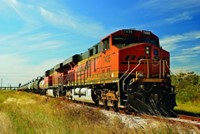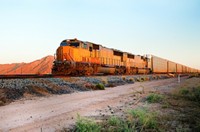Advertisement
Grab your lab coat. Let's get started
Welcome!
Welcome!
Create an account below to get 6 C&EN articles per month, receive newsletters and more - all free.
It seems this is your first time logging in online. Please enter the following information to continue.
As an ACS member you automatically get access to this site. All we need is few more details to create your reading experience.
Not you? Sign in with a different account.
Not you? Sign in with a different account.
ERROR 1
ERROR 1
ERROR 2
ERROR 2
ERROR 2
ERROR 2
ERROR 2
Password and Confirm password must match.
If you have an ACS member number, please enter it here so we can link this account to your membership. (optional)
ERROR 2
ACS values your privacy. By submitting your information, you are gaining access to C&EN and subscribing to our weekly newsletter. We use the information you provide to make your reading experience better, and we will never sell your data to third party members.
Safety
Shippers Redirect Rail Reform Efforts
Chemical firms take their beef over rates and service to a transportation board
by Glenn Hess
May 28, 2012
| A version of this story appeared in
Volume 90, Issue 22

Rail transportation is important to the chemical industry. In terms of volume, chemicals are the second-largest bulk commodity transported by rail after coal. But rail transportation costs vary widely depending on whether a shipper, regardless of type of cargo, is serviced by a single railroad—a so-called captive shipper—or benefits from multiple railroad servers that compete for its business.
The disparity in shipping costs is the basis for a long-simmering dispute over whether railroads are price gouging some of their customers, particularly industries whose plants are served by only one railroad. These shippers say they have little choice but to pay the railroad’s rate because of the lack of competition.
Railroads counter that shippers have access to other modes of transportation, including trucks and barges. And they argue that increased regulation would deprive the carriers of billions of dollars in annual revenues, making it impossible for them to fund capacity improvements. They claim this would ultimately lead to higher shipping costs, reduced service, and gridlock. Railroads transport about 40% of the nation’s cargo.
To break the long-standing impasse, the chemical industry, which includes a large number of captive shippers, has been pressing Congress for years to consider reforming the rail system. The going has been slow, and now that Congress’ attention is diverted by election-year politics, legislation to comprehensively reform U.S. rail policy has stalled.
Now the chemical industry is turning its attention back to the small but powerful federal agency that is tasked with the economic regulation of the freight railroad industry.
That agency is the Surface Transportation Board. STB, which resides within the Department of Transportation, was created by Congress in 1995 to settle rate and service disputes between shippers and railroads and to review proposed rail mergers.
About a year ago, the chemical industry took its complaints about competitiveness and costs to STB, which held a series of hearings on the matter. With Congress otherwise occupied, the industry now sees this board as its best hope for rate relief in the short term.
“We believe that competition among railroads has declined significantly in recent years,” says Thomas E. Schick, senior director of regulatory and technical affairs for the industry trade group American Chemistry Council (ACC). STB, Schick states, has the ability to revise outdated policies and to make changes that would enhance competition and improve the U.S. economy.
The debate among Washington, D.C., policymakers involves the proper type and scope of railroad regulation. High-volume freight shippers, such as chemical manufacturers, coal producers, and farmers, have been urging Congress to pass legislation to increase rail competition and strengthen federal oversight of the railroad industry. The current regulatory structure, they argue, has resulted in unreasonable rate increases and unpredictable service for many shippers.

The hyperpartisan atmosphere of an election year, however, means there is little chance that lawmakers will vote on controversial proposals designed to ensure that all shippers have access to reliable and cost-competitive rail transportation, says Calvin M. Dooley, president and chief executive officer of ACC, which represents the nation’s largest chemical companies.
But some members of Congress are continuing to pursue reform. Sen. John D. Rockefeller IV (D-W.Va.), chairman of the Senate Commerce, Science & Transportation Committee, is sponsoring a wide-ranging reform bill, S. 158, that is intended to inject more competition into the freight rail sector. The Senate committee had unanimously approved an earlier version of Rockefeller’s bill, S. 2889, in December 2009, but it never reached the Senate floor.
“It’s our assessment that the political environment right now is such that a Rockefeller-like proposal is not going to move forward” this year, Dooley says. Although S. 158 has bipartisan support at the committee level, he says, the bill wouldn’t be able to muster the 60 votes needed to pass the full Senate.
Meanwhile, in the House of Representatives, Transportation & Infrastructure Committee Chairman John L. Mica (R-Fla.) has said he opposes the changes that Rockefeller’s legislation would make. No companion bill has been introduced in the House.
The quarrel between freight railroads and shippers “pits some pretty strong constituencies against each other,” Dooley points out. The House Republican leadership “has made a determination that it shouldn’t put members in a position of picking sides when the Senate isn’t going to act.”

With the prospects for passing legislation slim, “you don’t see either the House or the Senate spending a lot of time on competition legislation,” Dooley says. “That’s why we’re focused predominantly on the regulatory arena right now, working with STB to ensure that they are effectively addressing restraints on competition.”
In response to the concerns raised by the chemical industry, the three-member STB held lengthy hearings in June 2011 to assess the overall state of competition in the railroad industry. At those hearings, railroad executives laid out their arguments against changing rail regulations. The railroads’ stance has not wavered.
The agency said it was sensitive to railroads’ concerns that new rules could hurt that industry’s financial health and reduce the amount of money available for track expansion and maintenance. But in response to long-standing concerns raised by some rail customers about consolidation in the sector and allegations of unfair pricing, STB said it would study whether regulatory changes are needed to spur competition.
“We need to strike a balance between providing access to competitive rail transportation for shippers while maintaining the rail industry’s impressive economic renaissance,” said Daniel R. Elliott III, a former attorney for the United Transportation Union who was appointed by President Barack Obama in 2009 to serve as the board’s chairman.
In the 1970s, railroads were struggling financially and going bankrupt under heavy government control. In response, Congress passed the Staggers Rail Act of 1980, which largely deregulated the industry and let carriers set rates and discard or spin off unprofitable routes. To help facilitate mergers and acquisitions and enable rail companies to become profitable again, Congress gave the industry a series of exemptions from federal antitrust laws.
Three dozen large railroads operated in the U.S. 30 years ago. Today, after more than 50 mergers and consolidations, there are only seven, two of which are Canadian. Additionally, the four biggest railroads provide over 90% of the freight rail transportation in the nation—Norfolk Southern Railway and CSX Transportation dominate the business east of the Mississippi River, while Union Pacific Railroad and Burlington Northern Santa Fe Railway dominate in the West, Midwest, and the Gulf Coast.
Rail operators say consolidation was inevitable and that it led to cost reduction, new economies of scale, and increased efficiency across the industry. But shippers contend that this concentration has resulted in regional monopolies, leaving many rail customers captive to a single cross-country carrier.
Nationwide, about 15–20% of rail traffic is from shippers served by one railroad and that have no other viable option, according to STB estimates. But in the chemical industry, nearly two-thirds of facilities that depend on rail service to bring in raw materials and deliver finished products have access to just one railroad, ACC says. “We think the railroad industry is, at times, using its quasi-monopoly position to establish rates that we think are not justified,” Dooley remarks.
In the last quarter of 2011, captive chemical shippers paid rates that were, on average, 104% higher than those paid by companies with access to competing railroads, according to Escalation Consultants, a shipping consulting firm.
This is a significant problem for the industry because chemicals are the second-largest rail-transported bulk commodity by volume. Chemical manufacturers shipped 192 million short tons of products by rail in 2011, generating $9 billion in revenues for the railroads.
“The reality is that individual shippers have found, particularly over the past six or seven years in all kinds of industries including ours, that rates have gone up by terrific amounts,” ACC’s Schick says.
ACC and a large coalition of captive rail customers have called on STB to put in place new rules that would make it easier for them to gain access to competing railroads on segments currently served by a single rail company. Currently, originating carriers can lock in long-haul shipments to the final destination and prevent shippers from getting bids from competing railroads at terminals and other connecting points along the route.
Requiring railroads to compete for business would lead to lower prices and better service for captive shippers, reform advocates argue. “We think STB has the authority to take strong action and provide captive shippers with the ability to access service from competing railroads,” says Jeffrey Sloan, senior director of ACC’s Chlorine Chemistry Division.
The board’s current policies “tend to restrict the ability of captive shippers to seek alternatives,” Sloan tells C&EN. “With some changes in those policies, STB can open up some additional avenues for captive shippers to realize some competitive balance.”
Railroads say they will continue to fight efforts by captive shippers to impose new rules on the industry. The certainty provided by the current regulatory framework “has helped create the safest, most efficient and affordable freight rail system in the world,” says Holly Arthur, assistant vice president for media and public relations at the Association of American Railroads (AAR), the industry’s main lobbying group.
AAR believes that the existing system provides rail customers with protections from market abuses, Arthur says. It also ensures that “railroads can earn the revenue needed to support the private capital investments that fund the nation’s rail network infrastructure so taxpayers don’t have to,” she remarks. Freight railroads spend more than $20 billion each year to maintain the U.S. rail network, according to the trade group.
Railroad officials have warned that any attempt to roll back provisions of the 1980 deregulatory law would jeopardize the industry’s success. During the 2011 STB hearings, Union Pacific Chairman James R. Young maintained that railroads are already subject to intense competition. “Each year, we lose and must replace over 10% of our business. We continually struggle with other railroads, trucks, and water carriers to win and retain business,” he asserted.

The Staggers Act, in addition to giving railroads the freedom to establish their own routes and tailor rates to market conditions, also allowed carriers to differentiate rates on the basis of demand. Rail operators contend that variable prices for competitive and single-source routes are necessary for railroads to survive. They argue that income from traffic on competitive freight routes is inadequate for railroads to earn a profit.
“Truth is, those customers calling for forced access really only want lower rates by eliminating differential pricing. But changing the rules for access is not a remedy for rate concerns,” AAR President Edward R. Hamberger told board members. STB already has authority to address customers’ concerns in individual rate cases, he pointed out.
Billions of dollars in rail revenue could be lost each year if railroads were forced to lower their rates for certain groups of shippers, Hamberger said. On average, he testified, inflation-adjusted rail rates for all rail customers have declined 51% since 1981.
Chemical industry officials say that a lot has changed in the three decades since the Staggers Act was passed and the overall financial health of the railroads has been restored. “It’s appropriate to consider how the policies put in place years ago address the current challenges,” Sloan says. “We think a strong case has been made for STB to aggressively take action to give shippers better access to competitive service.”
But going forward, AAR’S Arthur tells C&EN, it will be important for STB to address “the all-important question of how investment in the national rail network will remain sufficient to meet the projected demand for freight rail service.”
What action, if any, STB might take is uncertain. An STB spokesman tells C&EN that board members and their staff have been examining testimony from the hearings and additional comments filed by stakeholders. “The evidentiary record is closed and the board is now deciding where to go from here,” he says. There is no deadline for a decision, the spokesman adds.





Join the conversation
Contact the reporter
Submit a Letter to the Editor for publication
Engage with us on Twitter